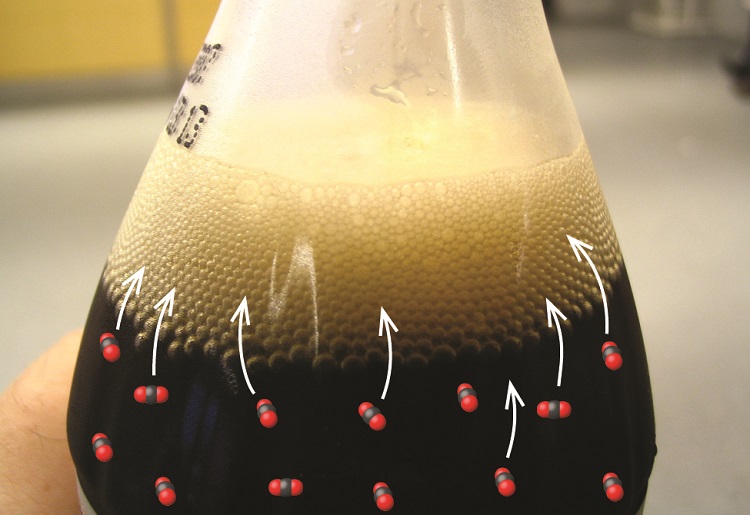PROBLEM \(\PageIndex{1}\)
How do solutions differ from compounds? From other mixtures?
- Answer
-
A solution can vary in composition, while a compound cannot vary in composition. Solutions are homogeneous at the molecular level, while other mixtures are heterogeneous.
PROBLEM \(\PageIndex{2}\)
Give an example of each of the following types of solutions:
- a gas in a liquid
- a gas in a gas
- a solid in a solid
- Answer a
-
CO2 in water
- Answer b
-
O2 in N2 (air)
- Answer c
-
bronze (solution of tin or other metals in copper)
PROBLEM \(\PageIndex{3}\)
Solutions of hydrogen in palladium may be formed by exposing Pd metal to H2 gas. The concentration of hydrogen in the palladium depends on the pressure of H2 gas applied, but in a more complex fashion than can be described by Henry’s law. Under certain conditions, 0.94 g of hydrogen gas is dissolved in 215 g of palladium metal. Determine the molarity of this solution (solution density = 1.8 g/cm3).
- Answer
-
3.91 M
- Click here to see a video of the solution
-
PROBLEM \(\PageIndex{4}\)
Explain why solutions of HBr in benzene (a nonpolar solvent) are nonconductive, while solutions in water (a polar solvent) are conductive.
- Answer
-
HBr is an acid and so its molecules react with water molecules to form H3O+ and Br− ions that provide conductivity to the solution. Though HBr is soluble in benzene, it does not react chemically but remains dissolved as neutral HBr molecules. With no ions present in the benzene solution, it is electrically nonconductive.
PROBLEM \(\PageIndex{5}\)
Consider the solutions presented:
(a) Which of the following sketches best represents the ions in a solution of Fe(NO3)3(aq)?
3_img.jpg?revision=1&size=bestfit&width=570&height=191)
(b) Write a balanced chemical equation showing the products of the dissolution of Fe(NO3)3.
- Answer a
-
Fe(NO3)3 is a strong electrolyte, thus it should completely dissociate into Fe3+ and \(\ce{(NO3- )}\) ions. Therefore, (z) best represents the solution.
- Answer b
-
\(\ce{Fe(NO3)3}(s)⟶\ce{Fe^3+}(aq)+\ce{3NO3- }(aq)\)
PROBLEM \(\PageIndex{6}\)
What is the expected electrical conductivity of the following solutions?
- NaOH(aq)
- HCl(aq)
- C6H12O6(aq) (glucose)
- NH3(l)
- Answer a
-
high conductivity (solute is an ionic compound that will dissociate when dissolved)
- Answer b
-
high conductivity (solute is a strong acid and will ionize completely when dissolved)
- Answer c
-
nonconductive (solute is a covalent compound, neither acid nor base, unreactive towards water)
- Answer d
-
low conductivity (solute is a weak base and will partially ionize when dissolved)
PROBLEM \(\PageIndex{7}\)
Why are most solid ionic compounds electrically nonconductive, whereas aqueous solutions of ionic compounds are good conductors? Would you expect a liquid (molten) ionic compound to be electrically conductive or nonconductive? Explain.
- Answer
-
A medium must contain freely mobile, charged entities to be electrically conductive. The ions present in a typical ionic solid are immobilized in a crystalline lattice and so the solid is not able to support an electrical current. When the ions are mobilized, either by melting the solid or dissolving it in water to dissociate the ions, current may flow and these forms of the ionic compound are conductive.
PROBLEM \(\PageIndex{8}\)
Suppose you are presented with a clear solution of sodium thiosulfate, Na2S2O3. How could you determine whether the solution is unsaturated, saturated, or supersaturated?
- Answer
-
Add a small crystal of \(Na_2S_2O_3\). It will dissolve in an unsaturated solution, remain apparently unchanged in a saturated solution, or initiate precipitation in a supersaturated solution.
PROBLEM \(\PageIndex{9}\)
Refer to following figure for the following three questions:

- How did the concentration of dissolved CO2 in the beverage change when the bottle was opened?
- What caused this change?
- Is the beverage unsaturated, saturated, or supersaturated with CO2?
- Answer a
-
It decreased as some of the CO2 gas left the solution (evidenced by effervescence).
- Answer b
-
Opening the bottle released the high-pressure CO2 gas above the beverage. The reduced CO2 gas pressure, per Henry’s law, lowers the solubility for CO2.
- Answer c
-
The dissolved CO2 concentration will continue to slowly decrease until equilibrium is reestablished between the beverage and the very low CO2 gas pressure in the opened bottle. Immediately after opening, the beverage, therefore, contains dissolved CO2 at a concentration greater than its solubility, a nonequilibrium condition, and is said to be supersaturated.


3_img.jpg?revision=1&size=bestfit&width=570&height=191)
